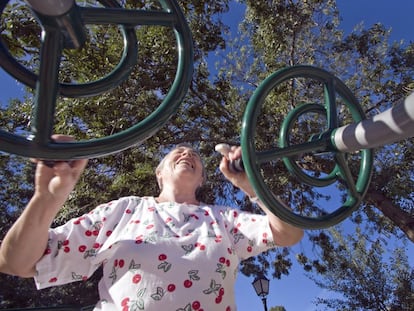Intense exercise could act as a ‘protective shield’ against metastatic cancer
A new study highlights the role of high-intensity aerobic activity in preventing the appearance of metastases; still, experts warn that it should not be considered a substitute for other treatments
Last November, the prestigious scientific journal Cancer Research dedicated its cover to a study carried out by researchers from the Tel Aviv University in Israel, which described the relevance of physical exercise in the fight against cancer. This choice of cover story was not trivial. For some time now, scientific evidence has pointed toward the important impact of physical exercise in preventing the appearance of certain types of cancer, as well as in improving tolerance to treatments and the quality of life of patients who already have been diagnosed with a tumor. However, this research, led by Carmit Levy from the Tel Aviv University’s Department of Human Genetics and Biochemistry and Yftach Gepner from the Israeli university’s School of Public Health, goes a step further, proving the remarkable impact that intense physical exercise can have in preventing the appearance of metastases, which are responsible for 90% of cancer deaths.
Previous studies have shown that physical exercise reduces the risk of some types of cancer by up to 35%, Gepner explained to EL PAÍS. This positive effect is similar to the impact of exercise on other conditions such as heart disease and diabetes. With this study they added new facts to this knowledge, suggesting that high-intensity aerobic exercise (which obtains its energy from sugar) can reduce the risk of metastatic cancer by up to 72%.
The study carried out by the Tel Aviv University researchers combined data from an epidemiological study that followed nearly 3,000 healthy people for two decades with data from an animal model (mice) that was trained under a strict exercise regimen. Both results were concurrent: participants who reported regular high-intensity aerobic activity – understood as one that brings the heart to 80% of its maximum rate, such as running, cycling or walking uphill – presented 70% less chance of developing metastatic cancer than those who did not exercise.
In the study, the researchers took samples of the internal organs of the animals before and after physical exercise, as well as after cancer injection, and found that the aerobic activity significantly reduced the development of metastatic tumors in lymph nodes, lungs and liver, explains Gepner, who adds that this evidence led to the hypothesis that this favorable outcome in both mice and humans was related to the higher rate of glucose consumption induced by physical exercise.
“By examining the cells of these organs, we observed an increase in the number of glucose receptors during high-intensity aerobic activity. Organs increased glucose intake and became effective energy-consuming machines, much like muscles in their operation. We assume that this happens because the organs have to compete for sugar resources with the muscles. Consequently, if cancer develops, the fierce competition for glucose reduces the availability of energy necessary for metastasis,” says the scientist.
Relevant data
The hypothesis put forward by the Tel Aviv University researchers is not new. “We know that the lack of availability of nutrients for the tumor affects the metabolic reprogramming of the tissues, because in this reprogramming there is less interaction with the tumor cells,” says Luis Paz-Ares, head of medical oncology at the Hospital Universitario 12 de Octubre in Madrid and president of the Spanish Association for Cancer Research (ASEICA), who believes that the study proves that if the tumor microenvironment is altered as a result of the increased metabolic needs induced by exercise, this same exercise can result in a kind of “protective shield” against the development of metastatic cancer.
Miguel Ángel Seguí, coordinator of the Exercise and Cancer Working Group of the Spanish Society of Medical Oncology (SEOM), is less optimistic. To him, the results of the research, despite being “very interesting,” lack a clear translation to the current recommendations, or an immediate application. “These results are what we call hypothesis generators and, therefore, they will have to be validated with more studies,” states the oncologist, who urges the data and the hypothesis proposed by the authors to be taken with great caution: “What is proposed in the study is one of several hypotheses being worked on in this field. However, we must take into account, with absolute certainty, that there is not one single mechanism that explains the effect of physical exercise on cancer prevention; surely there are different simultaneous mechanisms, which can also be more or less important depending on the type of cancer,” he explains.
Paz-Ares, on the other hand, reflects: “Is this evidence enough to spread to all kinds of patients and all kinds of cancers? That would be saying too much, but it is true that it presents relevant data and that, with the knowledge we already have, it helps to strengthen the evidence of common-sense recommendations, such as exercising, to prevent cancer.”
Thanks to its metabolic and physiological effects, Gepner emphasizes, physical exercise exhibits a higher level of cancer prevention than any drug or medical intervention to date. He believes that future studies will lead to the development of personalized treatments to prevent specific types of cancers, with doctors reviewing the family history of patients in order to recommend the right kind of physical activity.
Seguí agrees with this view, but points out that patients should not be led to believe that physical exercise is like a medicine that can replace other cancer treatments: “It must be seen as a complementary treatment, one that clearly helps to improve health and quality of life,” he concludes.
Sign up for our weekly newsletter to get more English-language news coverage from EL PAÍS USA Edition
Tu suscripción se está usando en otro dispositivo
¿Quieres añadir otro usuario a tu suscripción?
Si continúas leyendo en este dispositivo, no se podrá leer en el otro.
FlechaTu suscripción se está usando en otro dispositivo y solo puedes acceder a EL PAÍS desde un dispositivo a la vez.
Si quieres compartir tu cuenta, cambia tu suscripción a la modalidad Premium, así podrás añadir otro usuario. Cada uno accederá con su propia cuenta de email, lo que os permitirá personalizar vuestra experiencia en EL PAÍS.
¿Tienes una suscripción de empresa? Accede aquí para contratar más cuentas.
En el caso de no saber quién está usando tu cuenta, te recomendamos cambiar tu contraseña aquí.
Si decides continuar compartiendo tu cuenta, este mensaje se mostrará en tu dispositivo y en el de la otra persona que está usando tu cuenta de forma indefinida, afectando a tu experiencia de lectura. Puedes consultar aquí los términos y condiciones de la suscripción digital.
More information
Archived In
Últimas noticias
Most viewed
- Christian Louboutin: ‘Young people don’t want to be like their parents. And if their parents wear sneakers, they’re going to look for something else’
- ‘El Limones’ and the growing union disguise of Mexican organized crime
- Cartels in Mexico take a leap forward with narco-drones: ‘It is criminal groups that are leading the innovation race’
- The low-cost creative revolution: How technology is making art accessible to everyone
- ‘We are dying’: Cuba sinks into a health crisis amid medicine shortages and misdiagnosis











































